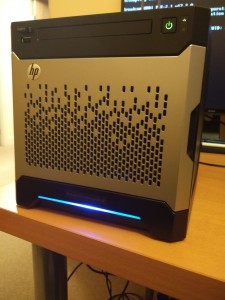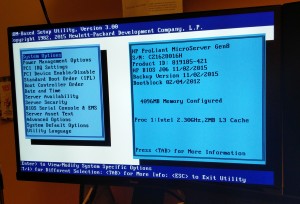HPE Microserver Gen8
It was about time I pensioned off the tired old Core2 Duo desktop running as my home fileserver. It sucked up sufficient electricity that it was worth having a Raspberry Pi sat on top of it, to issue a wake-on-LAN before running various tasks (e.g. backups) and turn it off again afterwards. It was also starting to develop reliability issues - who knew buying used-up hardware for a nominal £1 would barely give three years' service...
HP's Microservers have a good reputation as a basic home NAS box, and the £60 cashback offer running in November certainly helps: I got the Gen8 with a dual core 2.3Ghz Celeron and 4GB of RAM for £120 after cashback. Here it is:
It looks quite swish and is very quiet, especially if you select the power-saving options in the BIOS - it also puts out reassuringly little heat. The BIOS is quite nicely laid out and easy to follow, though it does seem to lack the classic "discard changes and exit" option.
Disks
It has four SATA bays which are inside the front door and have trays to slide the disks in and out with. They're not hot-swap apparently they are as long as you don't use the inbuilt RAID controller!, but at least physically moving disks in and out isn't a problem: they even supply a little tool to handle the screws with. I put the boot disk from my old server in the leftmost slot, and the two 1.5TB halves of my main RAID array in slots 2 and 3. It booted from the first disk and Just Worked, though the BIOS takes a while to wade through all the checks.
I believe it has some sort of built in hardware RAID controller, but I prefer to stick to good ol' fashioned Linux software RAID (newer, cooler solutions are also available): you can set up an array on any old hardware, plug the disks into something new and different, and it all comes back to life trivially. Linux is really good at moving to new hardware, and after an fsck* (even that could have been avoided if I'd set the system clock right) it was all ready to go. Try doing that with hardware RAID, where moving disks to a new controller is often impossible without wiping them and starting over.
Network
It has no less than three network ports on the back - two are ordinary dual NICs and the third is for HP's "iLO" remote management stuff. Since I've run out of ports on my router I haven't had a chance to try that out. Linux recognised the NICs as eth2 and eth3, but that might just be a hangover from the installation starting life on other hardware.
Other thoughts
I've only had it a few days, but it's been solid and reliable so far ... here's hoping it outlasts its Core2 predecessor by a good few years.
*File System ChecK - it's a Linux command. Obviously.

